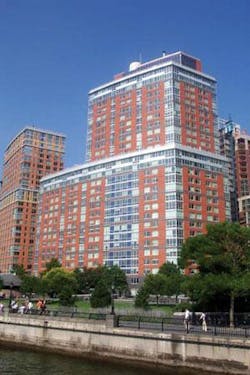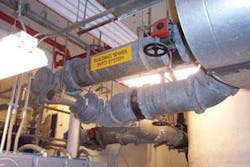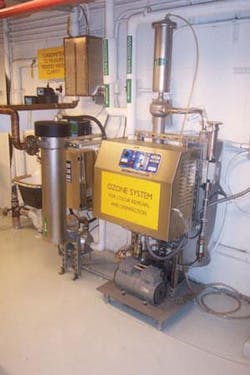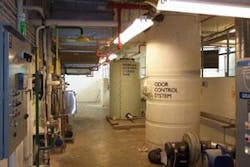Michael Zavoda
Soaring twenty-seven stories above the busy streets of lower Manhattan in New York City, stands the Solaire, the first “green,” high-rise apartment building in the USA.
Featuring 293 units ranging in size from studio to three bedrooms, the building is the first of its kind to receive a LEED Gold Certification from the US Green Building Council. Incorporating multiple green components, including solar energy, roof gardens and Energy Star® appliances, the Solaire is the definitive model for modern, environmentally sustainable living.
One of the Solaire’s most significant green components is a membrane bioreactor-based wastewater treatment and recycling system installed in the building’s basement. The system represents yet another milestone -- the first urban, residential treated wastewater reuse application permitted in the USA. The Hugh L. Carey Battery Park City Authority (BPCA) tapped American Water to develop the wastewater system, which began operation in January 2004. The company’s Applied Water Management group designs, builds and operates decentralized water and wastewater treatment plants, focusing on water reuse and environmental sustainability.
In 2000, the BPCA issued a set of Environmental Residential Guidelines, which established goals and standards for the creation of environmentally responsible residential buildings, such as the Solaire. These guidelines generally correspond with LEED criteria published by the U.S. Green Building Council, one of which focuses on Water Efficiency. Additionally, The New York City Department of Environmental Protection Comprehensive Water Reuse Program offers a 25 percent reduction in water and sewer charges for buildings with reuse systems that reduce potable water consumption by at least 25 percent. When designing the Solaire’s water reuse system and other water conservation measures, the BPCA met all of these guidelines and, in turn, enabled the building to qualify for New York State Green Building tax credits.
Photo by Applied Water Management/American Water
The Applied Water Management team custom designed an on-site, 25,000 gpd (gallons per day) wastewater system located in the basement of the Solaire. The system recycles and treats the building’s sewage for reuse, such as toilet flushing, HVAC cooling and subsurface irrigation of an adjacent park. The wastewater system is also intended to supply reclaimed water to an adjacent apartment building, and for use, with further treatment, for subsurface irrigation in adjacent Teardrop Park. The total treatment system, including treated water storage tanks, occupies an area of approximately 2,130 square feet.
The water reuse system designer was involved with the early civil and structural design decisions of the building, ensuring adequate success for installation, operation and maintenance of all equipment, and providing proper planning for the disposal of excess wastewater and the removal of biosolids. In the early planning stages, Applied Water Management had to convince the New York City Health Department that the reuse system was safe and not going to pose any health hazards to Solaire residents. Several meetings were held to determine acceptable effluent requirements and performance testing protocol; early tests demonstrated that highly disinfected water would be provided on a consistent basis.
The wastewater reuse system is designed to produce and supply only the water that is necessary for daily building usage; if the demand is low, it processes less, and vice-versa -- up to 25,000 gpd. The treatment system moves wastewater through a series of concrete tanks built into the basement wall:
1) A collection tank and trash trap removes plastic and other solids.
2) Wastewater then enters the bio-reactor, which contains very active bacteria used to consume or digest the biodegradable waste products in the wastewater.
Photo by Applied Water Management/American Water
3) The bioreactor contains two chambers: the anoxic, which operates without air, and the aerobic, which is aerated. Different kinds of bacteria thrive in each environment; pumps draw the mixture through spaghetti-like membranes that filter the liquid in the osmotic process.
4) Treated, filtered water passes through an ultraviolet disinfection system that kills any pathogens still present in the treated wastewater.
5) An ozone generator removes any traces of color and remaining pathogens.
6) Water flows to storage tanks, which serve as reservoirs for treated water. The water is ultimately used to flush toilets and as makeup water for the building’s cooling towers.
Engineers designed the reuse system to be highly automated with remote alarm and monitoring capability; a programmable controller that takes readings of flow rates and oxygen levels monitors overall system performance. The system requires an operator to visit twice a week for a few hours each visit.
In addition, the water reuse system includes a separate system that collects rainwater and stores it in a 10,000-gallon tank, also in the Solaire’s basement. The water is run through a sand filter and then chlorinated per New York City requirements. The captured stormwater is used to irrigate two planted, green roofs, located on the 19th and 28th floors, reducing the need for city-supplied potable water and minimizing flash flooding due to storm drain overflow.
Photo by Applied Water Management/American Water
The Solaire building consumes 50 percent less water than comparable New York City apartment buildings unequipped with water reclamation systems. Additionally, it uses 35 percent less energy than a similar building designed to New York State’s code requirements and 65 percent less electricity during peak demand periods. The building’s design incorporated 382 solar panels, which generate no less than 5 percent of the building’s base electrical load. Water reuse, especially, reduces the amount of potable water that is taken from the city’s water supply, while at the same time, saving the energy necessary to pump wastewater into a city treatment facility.
The Solaire project clearly illustrates what can be done in an urban setting to reduce demand on public water infrastructure and water resources overall. American Water is also in the initial design stages for systems serving several other buildings in the neighborhood, which has become a leading example of environmentally sustainable living.
The company has begun a second treatment and recycling treatment system to serve Tribeca Green, located on the same block as the Solaire. The building, designed by Robert A.M. Stern Architects, follows the BPCA residential environmental guidelines. It offers a host of environmentally-friendly features, including solar collection roof panels, rainwater recycling, an advanced airtight wall system and high performance windows in every home.
Photo by Applied Water Management/American Water
American Water has also been contracted to supply a third water treatment system for the Millennium Tower Residences, currently under construction at the southern end of Battery Park City. The 340,000 square foot tower will offer 236 condominium apartments and sit adjacent to The Ritz-Carlton Hotel and Residences New York, Battery Park. This is the fourth “green” building to be constructed in Battery Park City; the project is slated for completion by the end of 2006.
Author’s Note
Michael Zavoda is a managing engineer with Applied Water Management Group of American Water, with headquarters in Hillsborough, New Jersey, USA. An integrated part of American Water, the company offers water-related solutions to real estate developers, industrial clients, and small- to mid-sized communities.
American Water provides water, wastewater, and other related services to more than 18 million people in 29 states and 3 Canadian provinces. More information can be found by visiting www.amwater.com.








